Equipment Needed: Stiff Rope Halter with Nose Knots, a Training Stick (without the string), 14′ to 15′ Lead Rope
Training Needed: De-Sensitizing is a necessary pre-requisite for this exercise
A difference between pushing and driving. Pushing is a steady pressure that a horse can push back against. Driving is a rhythmic pressure that demands movement away from the driver.
The Goal
This is an easy but multi-faceted and VERY IMPORTANT lesson. The immediate goal of this exercise is to teach your horse to move his “dangerous” rear end away from you with just a slight request. The lesson progresses from
1. simply taking a step away to
2. taking the step in a precise manner to
3. actually moving his rear 180 degrees away from you and giving you his full-face attention.
Along the way, he will also begin to realize that you have different body postures that mean different things:
Active (Aggressive or forceful-posture with eye contact and body leaning in)
passive posture (little eye contact and less upright: more casual).

For safety, disengaging a horse’s rear is of paramount importance from the very beginning. It teaches him that you call the shots over his most powerful weapon (his kicking apparatus). It allows you to easily maneuver his rear end during general handling. Additionally, turning a horse’s rear 180 degrees away from you automatically brings his face toward you. He can’t learn what he does not see and pay attention to.
The Steps

Your hand nearest his halter holds a couple of loops of rope. Your hand toward his rear has a 3 ft dangle of rope with the popper – ready to swing if needed.
Standing with your side to your horse at his shoulder, begin to pressure his rear with your gaze and body position looking intently at his fanny and haunch. Be formidable (like a hungry tiger who will attack and eat his rear if he does not hide it.) Stare at his rump and point to his hind quarters as you move toward his haunch steak.
If he just lets you run into him, your posture is getting no result. At that point, re-adjust back to your starting position and twirl your rope popper at his rear (without touching him but twirling in an air rhythm to the count of 1-twirl, 2-twirl, 3-twirl, 4-twirl. Showing intent to move into him and slap him with the popper. The intense position you adopt will encourage him to “hide” his hindquarters from your predatory gaze. The twirling rope will apply more pressure for him if he wishes to avoid the impending contact with the popper.
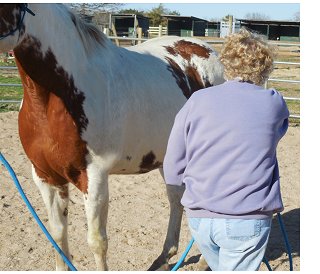
Carry your action forward and begin to step into his rear space (moving from his shoulder but stay in front of his haunches to stay out of striking distance).
Potential Problems: If he begins to move his shoulder into you, raise your close arm to prevent his shoulder from coming into your space or bumping into you. If he begins to back up, follow him but keep asking for the rear to move away. He doesn’t know what you want yet. He may try several alternative actions to stop the pressure, but eventually he will pivot his rear away at which point you must immediately stop and tell him he did a good job.
Many sensitive horses will turn their hindquarters away from you as long as you “threaten” them with the intense stare and purposeful movement. More reluctant horses will not react yet.
Additionally, a horse who is well de-sensitized won’t realize that the rope is asking for him to move away. We just spent time showing him that the swinging rope was a neutral object. It is your body posture that tells him to move and he is not yet an expert in observing that.
If he does not move, swing the popper end of your lead to make contact with and tap his rump steadily and rhythmically. Start steady-but-light: “tap, tap, tap, tap, tap, tap… See if you can “irritate” him into moving. If he just ignores the small taps, build pressure, getting harder and harder until he moves his rear away: Tap, Tap, Tap, Tap, Tap, Tap… TAP! TAP! TAP! TAP!”. Accept a baby step move-away at first. Stop popping/tapping IMMEDIATELY, relax your posture to drop your predatory stance. Move in to rub his fanny with the rope while he rests.
Repeat this request to move, and stop pressuring each time he takes a step away. Rub the tap away. He will learn that the popper or stick has no purpose unless your body language indicates that it is to be heeded.
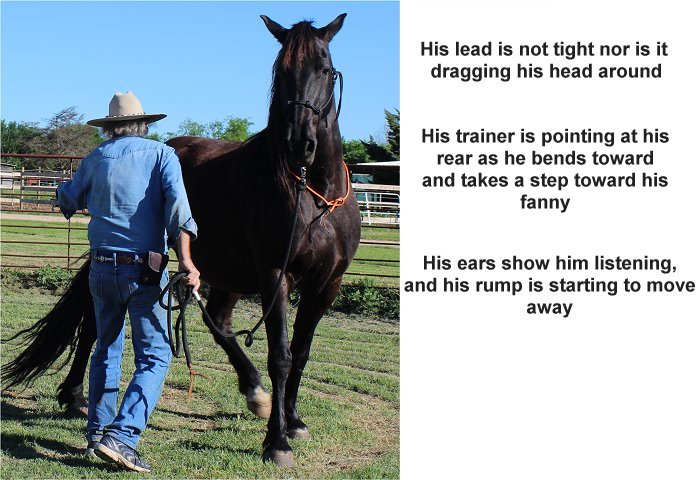
A very sensitive horse will take very little time to accomplish this maneuver. Many times a very sensitive horse will over-react and jump away or move backward too quickly if you do not start very lightly. Don’t raise the pressure. Just follow until the step is taken in the right direction.
A very lazy or disrespectful horse may take considerable more force to take you seriously. In fact, a habitually dominant horse might even threaten to kick or get tough. If you feel you have this type of horse, use a handy stick instead of your rope to ask for the move. It will keep you away from his kicking zone. Move to the heightened TAP! more quickly. Start light but go to “I mean it” much more quickly, skipping the middle pressure level.
As he catches on to the fact that if he moves, you will stop aggressing, he will move his hindquarters away more quickly – moving at the first sign of your body posture instead of waiting for the uncomfortable tapping to begin. This is where the light bulb goes off, and he begins to anticipate the next step (the tap) and avoid it by moving first.
You will see more and more mouth-chewing and licking behavior as he really learns this lesson. The mouth movement is a sign of relaxation and your signal that the lesson is settling in.

If you prefer to use a handy stick, go through the same sequence with the stick. Start by stirring the air at his rump. If no success, start rhythmically tapping in small taps, escalating the tap until you get a step away with his rear. tap, tap, tap, tap… Tap, Tap, Tap, Tap…TAP! TAP! TAP! TAP!”
All upcoming lessons build on this sequence of growing pressure and a horse’s natural inclination to anticipate and avoid the discomfort. Done well, he should be moving away with just your body language “requesting” the move rather than more pressure demanding it. Over time, your body posture will be more and more subtle and his perception more and more precise.
Potential Problems: If your horse begins to anticipate that he should disengage every time you walk up to his side, you are not moving up and down his side with your hands or giving him enough variety of activities between disengaging requests. Each time you approach, you should ask for him to either stand and get rubbed up and down his side (including his fanny) or disengage (depending on your posture). A more casual approach that ends in a rub-down and then a retreat is interspersed with your more assertive approach with a request to disengage. He must pay attention or he will make the wrong decision.
Now is the time to shape or refine this exercise into a pivot on the fore. Once you have movement, you want a precise type of movement: Your horse must take a step away and in doing so, pass his inside rear foot over his outside foot before you release. No release of pressure unless the foot moves correctly. You have to watch carefully to release when the proper step is accomplished.

Remember that as you introduce the new step, accept just ONE acceptable step-over and then release. He might have to take three or four steps before he does the correct step. Don’t release until he does the correct step-over.
This is actually easy, and most horses get the idea in just three or four tries.
Why do we want his rear legs to cross? When he moves his rear away in this manner, he is giving all of his rear power away. A horse with his legs crossed cannot run or kick. He is rendered defenseless. It signals a change in both his physical abilities and his fight/flight attitude toward your leadership, showing that he no longer feels the need to protect himself.

Start asking for two proper steps. When he reliably gives you two, ask for three. Don’t release until you get three steps with the proper crossover.
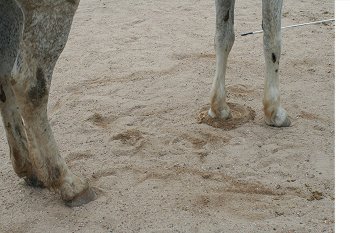 Look down at the sand. If he has done his job properly, you will see that his close front foot has drilled a hole in the dirt – never moving – while his rear swung all the way around.
Look down at the sand. If he has done his job properly, you will see that his close front foot has drilled a hole in the dirt – never moving – while his rear swung all the way around.
Your Initial Rear Disengage is complete.
(See the rear cross in the last frame of the paint horse in the animation above and the cross-over of the grey mare below.)
The dance can be refined until he is making a complete pivot on his fore with the inside front leg “drilling” a hole into the ground while his rear legs cross over around the complete 360 degree maneuver.
Disengage and Face Me
 The next step is to get the horse to not only disengage the rear by moving away from your push-bubble, but to actually twirl away fast enough to swivel all of the way 180 degrees and end up facing you. The Friesian mare to the left is in the correct ending position.
The next step is to get the horse to not only disengage the rear by moving away from your push-bubble, but to actually twirl away fast enough to swivel all of the way 180 degrees and end up facing you. The Friesian mare to the left is in the correct ending position.
To accomplish this, you will start with tapping or twirling the air to request the disengage, but put more intensity into it more quickly.
Your horse will be surprised by the fact that moving was met with a more intense contact with the rope or stick more quickly than he anticipated. What was acceptable earlier is no longer sufficient. He allowed the stick or popper to catch his rear, and he paid the price.
His surprise will cause him to swing his rear further with more energy, which will take it further away from you. Just what you want. A couple of surprising TAP!s will send the rear 180 degrees around and end with him facing you straight on. Stop the pressure and reward with a rest and some face stroking. Rear Disengage and Facing is accomplished.
From this position, your horse is ready to take further requests from you.
Remember that because a horse’s brain is not as efficiently cross-connected as a human brain, all of this has to be taught on each side of his body to get proficiency on both sides.
Disengage from the Front Using Visual Pressure: The Peek and Move Maneuver
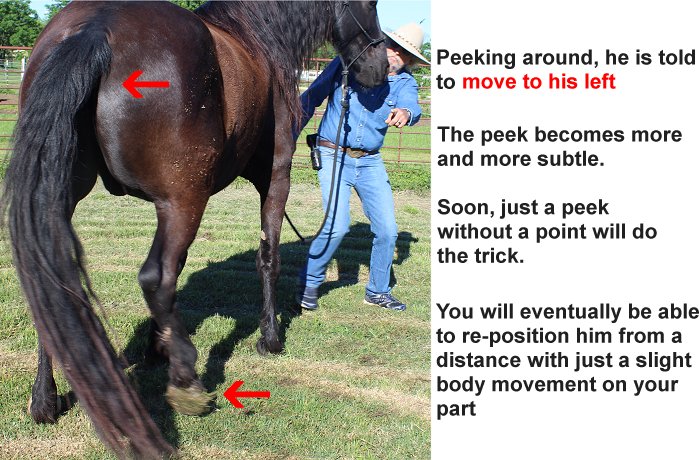
When your horse is sufficiently sensitive to your body posture to disengage when you are standing at his side, try standing in front and looking at his rear. Bend a little, and move your body slightly in the opposite direction you want him to move. If you move right and peek at his rump, he should take a step away from your vision to HIS right, bringing his eyes front and facing you squarely again. Stand up casually, and let him rest as a reward. Then move back to center.
If you peek and he does not move, point at his rump and move assertively toward it until he hides it. Then relax and move back to center. It rarely takes very long before he understands.
Now move left, bend slightly and look at his rear from the left. This should be sufficient for him to try to hide his fanny from your gaze by moving it one step to his left. Again this brings his face squarely toward you.
Do this a couple of times just to see how nice it is to square him up from a distance if you need to. The “Peek and Move” is not only useful, it really begins to use subtle body language and eye contact to give him cues. As a bonus, it will impress your friends.
See more intricate maneuvers involving disengaging the rear in preparation for under-saddle work here
Disengage Using Direct Pressure
The goal of this exercise is to get a horse to move his fanny away from you with the touch of your hand (or heel) on his side or his butt. It is very practical when you are grooming or tacking or in tight quarters and you want him to change his position without a fight or a pushing match. There are other times when moving his rear away makes life easier. This is also the introduction for pressure in an area that you will use when under saddle to disengage his rear with your boot or spur.
This part of the Rear Disengage is accomplished only if the horse is de-sensitized to your hands and touch.
The horse in this video is being cued by a small pulsating nudge in the side. It is not the exact procedure described verbally below, but it is effective.
To accomplish this move-over, stand facing your horse’s side, hold your rope loops in your halter-side hand and about 1 foot of popper that can be bounced off of his rear in the other. Get his face tipped toward you.
 Gently but firmly press your thumb. fist, or palm into his side at a point just behind the cinch. If he does not move at the count of 1-1000 2-1000, lightly tap his fanny, increasing in intensity until he takes a step away (using the correct crossover step). Stop all pressure and rub the “nudge” away while he rests pressure-free.
Gently but firmly press your thumb. fist, or palm into his side at a point just behind the cinch. If he does not move at the count of 1-1000 2-1000, lightly tap his fanny, increasing in intensity until he takes a step away (using the correct crossover step). Stop all pressure and rub the “nudge” away while he rests pressure-free.
Always rub the nudge until the horse stops moving his feet and gets soft. The rub-away is a cue that you are no longer pressing the exercise.
Repeat until he moves on the nudge pressure without the popper. (In the video, the handler uses his hand to tap the fanny instead of a popper)
Remember that he will be as light and easy to move as your first nudge/pressure-contact, so the request pressure should be small and light: just enough that he notices you are pressing a little. Don’t increase the request pressure, increase the tap until he moves.
 Perform the same procedure using his haunch as the pressure point.
Perform the same procedure using his haunch as the pressure point.
Now you have a horse whose rear is easy to maneuver in any circumstance with the lightest cue.
Potential Problems:
A very sensitive horse will over-react and go flying away. Lower the popper pressure a little.
A lazy horse will ignore your nudge until he gets a much firmer tap. He may need a spank! after a gentle nudge. Watch and be careful of a pushy horse that might kick out at you.
A horse the kicks out needs a serious spank. Just stay out of the kick zone when you do this.
If the horse walks in a circle instead of pivoting, bring her head around much further. If her head is tipped further toward her ribs, it is harder to walk out of the maneuver.
Anticipation: Horses quickly think that any time you move to their side and tip their head in, you will ask for the rear disengage. If that is the case, intersperse more flex-only exercises so that she cannot anticipate which you will want. Also, if you are going to ask for no movement, gently run your hand down his back or side as you go from head to tail.
A horse will be as light as the lightest request you give him. If you start very light and he learns to anticipate at the lightest cue, he will be very sensitive to your request.
In the case of the first disengage maneuver, the lightest cue was your body posture and visual gaze at his rear haunch. In the case of the hand-pressure cue, the thumb is just insistent enough that he notices your request.
Thank you Kristull Ranch in Austin, Texas for the horses and pictures. The demonstrator horse is Kristull Reign, an 8-yr-old 3/4 Friesian X Tennessee Walker who was imprinted at birth but never started any type of training until he was brought in from his pasture life as a 6-yr-old.
Horse training can be dangerous. Not all methods work on all horses. Instruction presented here is not meant to be prescriptive in nature, and Horse-Pros.com takes no responsibility for the welfare of any animal or person using our methods.
We certainly don’t know everything. Please share your expertise and experiences. Comment on what is already written or Suggest a Category and Educate us about it. Grow Horse-Pros.com©
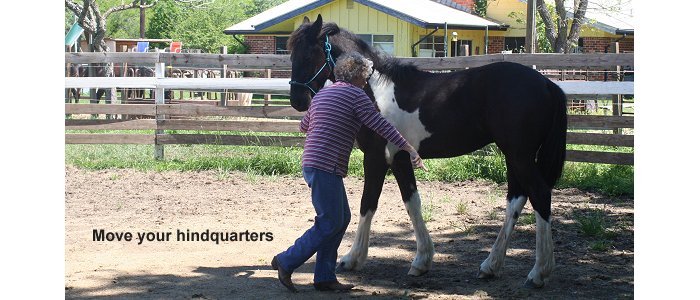
Actually very useful exercises. I’d say they are musts! I liked the way you described them, providing these photos and videos. Really great article. I’ll definitely share it with my friends/horseriders.